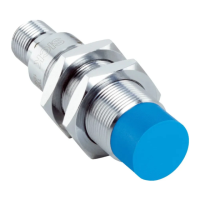2. Connect the computer to the IO-Link master (Mini USB) via the USB interface.
3. Supply IO-Link master with voltage.
4. Start computer.
5. Call up the SOPAS ET configuration software.
6. Load the device description file (*.SDD) of the current device type in SOPAS ET.
Start up the device on the basis of the factory default settings.
7. Configure the device as required with SOPAS ET.
For information on the device functions, see "Operation", page 33.
8. Present a described HF transponder to the device. Make sure the transponder is
optimally aligned to the device when doing so, see "Mounting the device", page 24.
Observe the read results in the process data.
9. The device automatically saves the changes of optimized parameters, if any. No
manual saving is necessary. The data can also be stored on the computer as a
parameter set (project file) for archiving purposes.
7.1.2 Commissioning and integration into a fieldbus system
Commissioning is done with the help of the PLC.
TransponderRFH5xxSIG200 (IO-Link Master)PLC
1 2 3
1
PLC
2
SIG200 (IO-Link Master)
3
Transponder
Prerequisites:
•
IO-Link master, z.B. SICK SIG200, connected to the PLC via fieldbus
•
Common PLC configuration tool, if necessary function block for the device instal‐
led
•
Type-specific IODD of the device (RFH5xx) for transfer to the PLC
Procedure
1. Connect the device (RFH5xx) to the voltage-free IO-Link master via IO-Link.
2. Connect IO-Link master to PLC via fieldbus.
3. Supply IO-Link master with voltage.
4. Load IODD of the device into IO-Link master.
5. Optional: Select Data Storage in port configuration of the master.
6. Configure device as desired.
For information on the device functions, see "Operation", page 33.
7. Commissioning by communication via the function block of the device.
8. Present a described UHF transponder to the device. Generate continuous reading
with the help of the PLC. Make sure the transponder is optimally aligned to the
device when doing so, see "Mounting the device", page 24.
9. Check the selected parameter values for suitability in operative use and optimize if
necessary.
7
COMMISSIONING
32
O P E R A T I N G I N S T R U C T I O N S | RFH5xx 8025309/1KDE/2023-12-19 | SICK
Subject to change without notice

